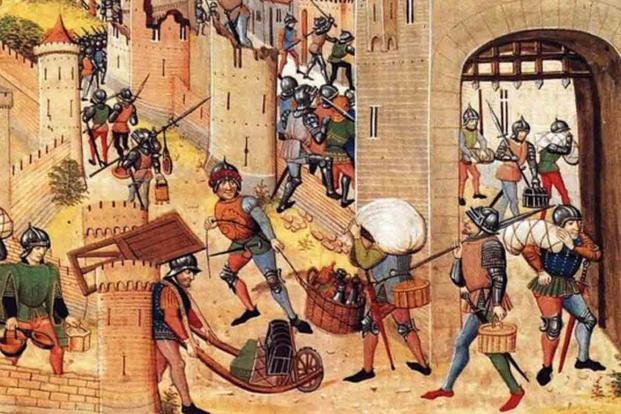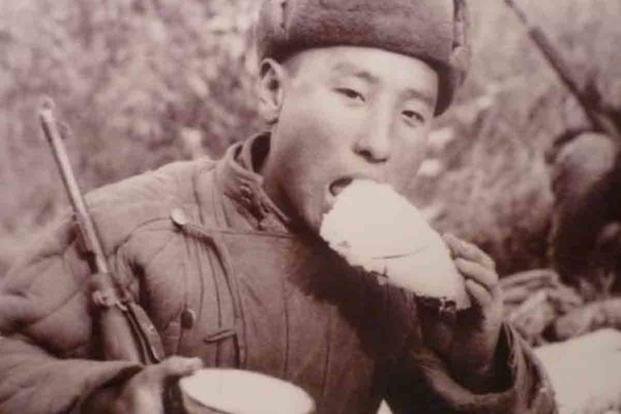We can say what we want about MREs (and we will), but compared to the other kinds of food handed out to military forces throughout history, the United States has it pretty good. By this standard, even C-rations and K-rations were a godsend.
It might even be said that the quality of American troops is related to the quality of their food. Two days after landing at Normandy, the U.S. was able to make hot food and fresh-baked bread and look at what happened: the liberation of Europe.
Still, despite the hardships of being at war, a lot of countries made do and even won wars with terrible food -- but that shouldn't be the goal.
1. Everyone: Hardtack Bread
If you bake something long enough, the moisture will evaporate and it'll keep for longer. This "secret" is one used by armies from the days of ancient Egypt up until World War I. Union soldiers in the American Civil War even complained of eating leftover hardtack from the Mexican War 15 years prior.
Made from salt, flour and a little bit of water, the Romans called it buccellum. Crusaders called it "muslin biscuit." Whatever you call it, it's just really, really hard bread. Eating it meant crushing it with something heavy (British sailors used cannonballs), mashing it into some kind of liquid and skimming the weevils from the liquid before consuming.
The oldest piece of hardtack still in existence is currently in a museum in Denmark, after being baked in 1851.
2. Crusaders: Pottage
Christian soldiers who were able to sack a Muslim camp during the Crusades would often stop fighting the battle they were currently winning so they could eat the enemy's food, even if it meant losing the battle and being slaughtered. According to John Hosler, associate professor of military history at the U.S. Army Command & General Staff College, they did it twice at the Siege of Acre.
The reason was probably because their main source of food was around 500 calories of pottage, a stew of boiled grains. If they were lucky, they might find something in the local area they could throw into the stew with it. Going off to war was pricey, and the Christian soldiers of Europe usually could take only what they could afford, which wasn't much more than a barley sack.

3. Mongols: Horse Blood and Milk
Having never drunk horse blood or milk, we can definitively say this is a terrible meal, and the Mongols did conquer the second-largest land empire ever, so credit this meal for that. Still, the Mongols relied on their horses for so much, they were known to say, "If the horse dies, I die."
According to explorer Marco Polo, the Mongols' feasts of horse blood and milk allowed them to ride for 10 days without stopping to light a fire. The milk of the horse could even be fermented to make kumiss, a low-alcohol beverage that, by all accounts, is very filling.

4. United States: "Embalmed Beef"
The Spanish-American War was the United States' first overseas war, and it was one the U.S. Army was ill-prepared for, especially in terms of feeding its troops. The Army needed food fast, and American meat companies were ready to respond. In the days before the Food and Drug Administration, the industry could pretty much do what it wanted -- and in the Spanish-American War, it did.
By the time the beef, either canned or refrigerated, arrived at the front, it smelled like an embalmed dead body. This was because it was later found to have been treated with harmful chemicals, like formaldehyde. Many men wouldn't eat it, but those who did suffered from food poisoning. One who did eat it, Theodore Roosevelt, would later become president of the United States and championed the Pure Food and Drug Act.

5. China: "Chow Mein"
This is not the chow mein we're used to seeing on Chinese takeout menus nationwide. It's also not even the canned stuff you get at the grocery store. During the Korean War, the chow mein used by the Chinese People's Volunteer Army was less like a noodle dish and more like a wet, crumbled hardtack.
In truth, it was actually more like a handful of dried, ground grains. When mealtimes came, the Chinese soldiers would add a little water to their flour and eat it cold as a porridge. If water wasn't readily available because supply lines were being bombed by the United Nations, Chinese volunteers would grab up handfuls of snow to mash into it.

-- Blake Stilwell can be reached at blake.stilwell@military.com. He can also be found on Twitter @blakestilwell or on Facebook.
Want to Learn More About Military Life?
Whether you're thinking of joining the military, looking for post-military careers or keeping up with military life and benefits, Military.com has you covered. Subscribe to Military.com to have military news, updates and resources delivered directly to your inbox.
















